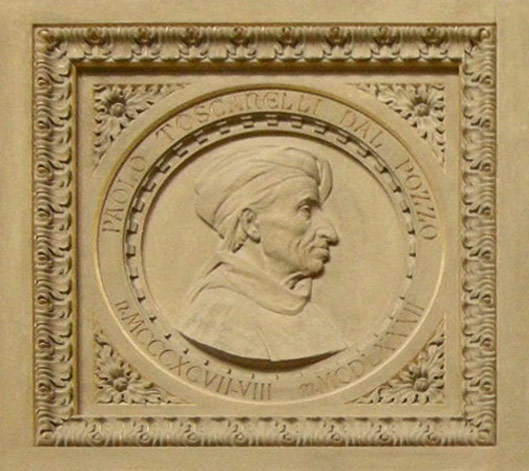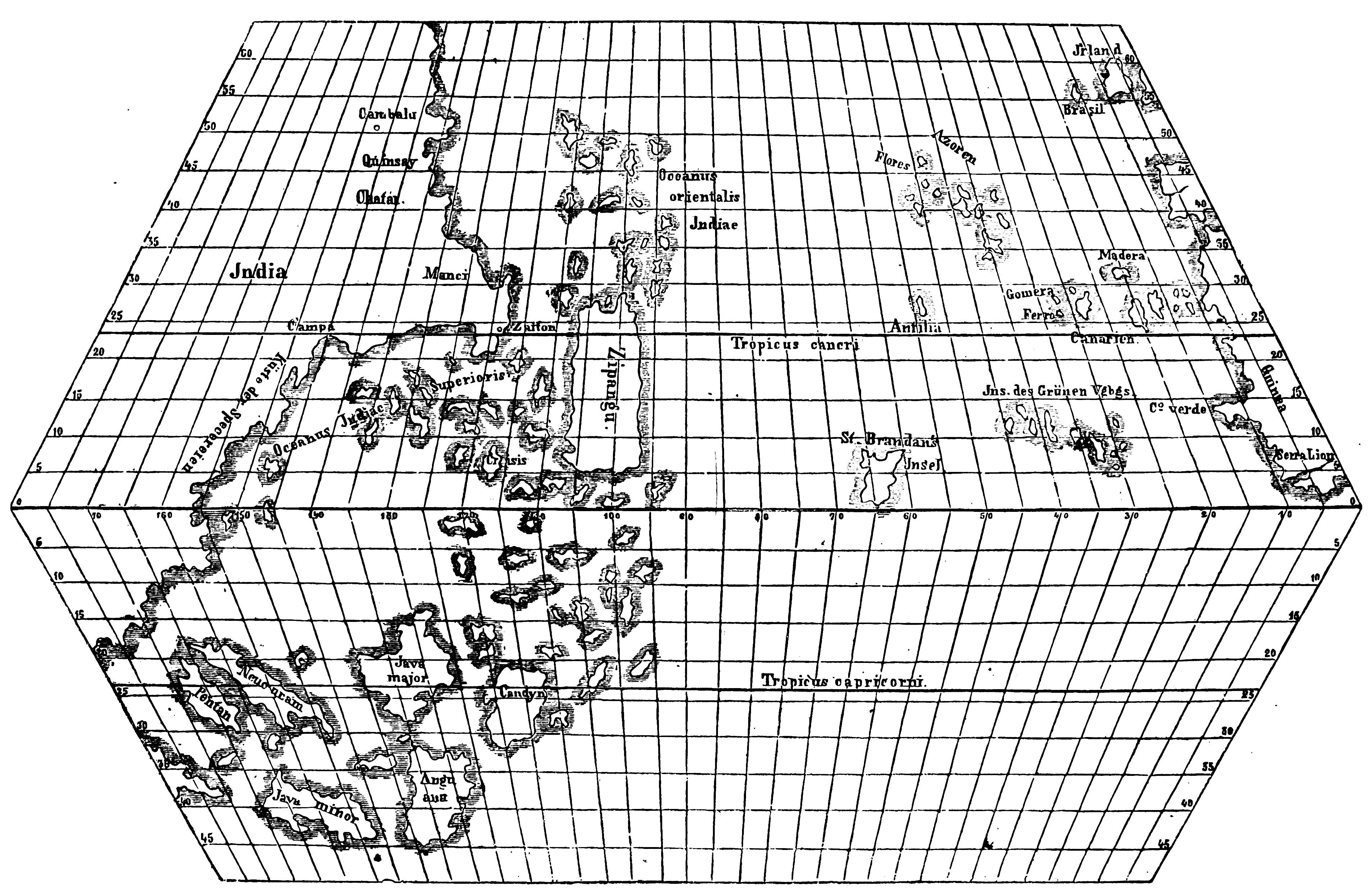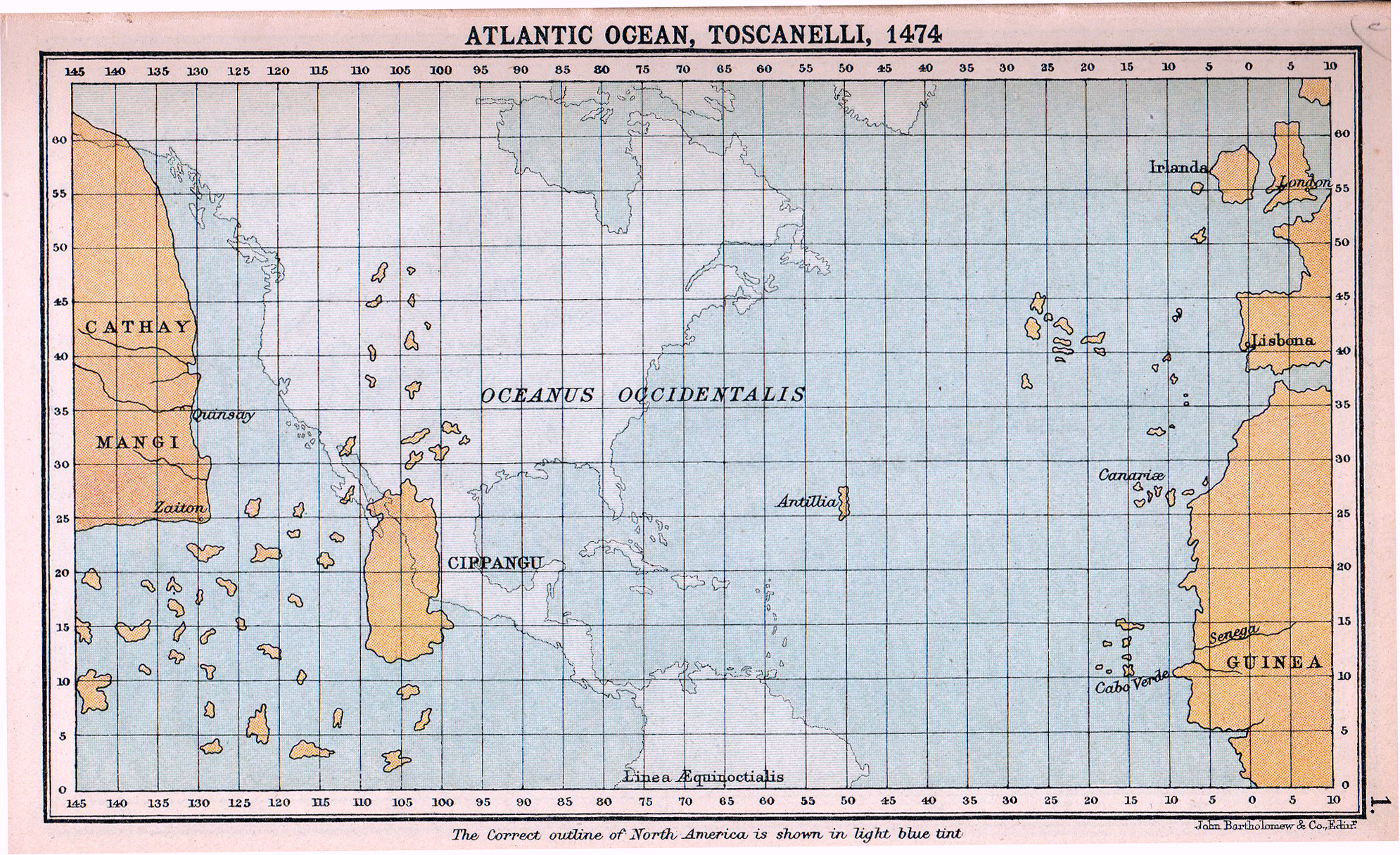Toscanelli on:
[Wikipedia]
[Google]
[Amazon]

 Paolo dal Pozzo Toscanelli (1397 – 10 May 1482) was an Italian
Paolo dal Pozzo Toscanelli (1397 – 10 May 1482) was an Italian
 In 1474, Toscanelli sent a letter and a map to his Portuguese correspondent Fernão Martins, priest at the
In 1474, Toscanelli sent a letter and a map to his Portuguese correspondent Fernão Martins, priest at the

 Paolo dal Pozzo Toscanelli (1397 – 10 May 1482) was an Italian
Paolo dal Pozzo Toscanelli (1397 – 10 May 1482) was an Italian mathematician
A mathematician is someone who uses an extensive knowledge of mathematics in their work, typically to solve mathematical problems.
Mathematicians are concerned with numbers, data, quantity, structure, space, models, and change.
History
On ...
, astronomer
An astronomer is a scientist in the field of astronomy who focuses their studies on a specific question or field outside the scope of Earth. They observe astronomical objects such as stars, planets, natural satellite, moons, comets and galaxy, g ...
,, pp. 333–335 and cosmographer
The term cosmography has two distinct meanings: traditionally it has been the protoscience of mapping the general features of the cosmos, heaven and Earth; more recently, it has been used to describe the ongoing effort to determine the large-scal ...
.
Life
Paolo dal Pozzo Toscanelli was born inFlorence
Florence ( ; it, Firenze ) is a city in Central Italy and the capital city of the Tuscany region. It is the most populated city in Tuscany, with 383,083 inhabitants in 2016, and over 1,520,000 in its metropolitan area.Bilancio demografico an ...
, the son of the physician Domenico Toscanelli. There is no precise information on his education and background. Gustavo Uzielli claimed in 1894 that Toscanelli studied at the University of Padua
The University of Padua ( it, Università degli Studi di Padova, UNIPD) is an Italian university located in the city of Padua, region of Veneto, northern Italy. The University of Padua was founded in 1222 by a group of students and teachers from B ...
, but modern authors consider this pure conjecture.
Toscanelli is noted for his observations of comet
A comet is an icy, small Solar System body that, when passing close to the Sun, warms and begins to release gases, a process that is called outgassing. This produces a visible atmosphere or coma, and sometimes also a tail. These phenomena ar ...
s. Among these was the comet of 1456, which was to be named Halley’s Comet
Halley's Comet or Comet Halley, officially designated 1P/Halley, is a short-period comet visible from Earth every 75–79 years. Halley is the only known short-period comet that is regularly visible to the naked eye from Earth, and thus the o ...
after Edmond Halley predicted its return in 1759.
Thanks to his long life, his intelligence and his wide interests, Toscanelli was one of the central figures in the intellectual and cultural history of Renaissance Florence
Florence ( it, Firenze) weathered the decline of the Western Roman Empire to emerge as a financial hub of Europe, home to several banks including that of the politically powerful Medici family. The city's wealth supported the development of ar ...
in its early years. His circle of friends included Filippo Brunelleschi
Filippo Brunelleschi ( , , also known as Pippo; 1377 – 15 April 1446), considered to be a founding father of Renaissance architecture, was an Italian architect, designer, and sculptor, and is now recognized to be the first modern engineer, p ...
, the architect of the Florence Cathedral
Florence Cathedral, formally the (; in English Cathedral of Saint Mary of the Flower), is the cathedral of Florence, Italy ( it, Duomo di Firenze). It was begun in 1296 in the Gothic style to a design of Arnolfo di Cambio and was structurally c ...
, and the philosopher Marsilio Ficino
Marsilio Ficino (; Latin name: ; 19 October 1433 – 1 October 1499) was an Italian scholar and Catholic priest who was one of the most influential humanist philosophers of the early Italian Renaissance. He was an astrologer, a reviver of ...
. He knew the mathematician, writer and architect Leon Battista Alberti, and his closest friend was Cardinal Nicholas of Cusa
Nicholas of Cusa (1401 – 11 August 1464), also referred to as Nicholas of Kues and Nicolaus Cusanus (), was a German Catholic cardinal, philosopher, theologian, jurist, mathematician, and astronomer. One of the first German proponents of Renai ...
—himself a wide-ranging intellect and early humanist, who dedicated two short mathematical works in 1445 to Toscanelli, and made himself and Toscanelli the interlocutors in a 1458 dialogue titled ''On Squaring the Circle'' (''De quadratura circuli''). When Nicholas of Cusa was on his death bed in the remote Perugian town of Todi in 1464, Toscanelli traversed 120 miles from Florence to be with him.
Toscanelli along with Nicholas of Cusa appears to have belonged to a network of Florentine and Roman intellectuals who searched for and studied Greek mathematical works, along with Filelfo
Francesco Filelfo ( la, Franciscus Philelphus; 25 July 1398 – 31 July 1481) was an Italian Renaissance humanist.
Biography
Filelfo was born at Tolentino, in the March of Ancona. He is believed to be a third cousin of Leonardo da Vinci. At th ...
, George of Trebizond, and the humanist Pope Nicholas V, in company with Alberti and Brunelleschi.
In 1439, the Greek philosopher Gemistos Plethon, attending the Council of Florence
The Council of Florence is the seventeenth ecumenical council recognized by the Catholic Church, held between 1431 and 1449. It was convoked as the Council of Basel by Pope Martin V shortly before his death in February 1431 and took place in ...
, acquainted Toscanelli with the extensive travels, writings and mapping of the 1st century BC/AD Greek geographer Strabo
Strabo''Strabo'' (meaning "squinty", as in strabismus) was a term employed by the Romans for anyone whose eyes were distorted or deformed. The father of Pompey was called "Pompeius Strabo". A native of Sicily so clear-sighted that he could see ...
, hitherto unknown in Italy. Nearly 35 years later, the Italian was to follow up this amplified knowledge.
 In 1474, Toscanelli sent a letter and a map to his Portuguese correspondent Fernão Martins, priest at the
In 1474, Toscanelli sent a letter and a map to his Portuguese correspondent Fernão Martins, priest at the Lisbon Cathedral
The Cathedral of Saint Mary Major ( pt, Santa Maria Maior de Lisboa or ''Metropolitan Cathedral of St. Mary Major''), often called Lisbon Cathedral or simply the Sé ('), is a Roman Catholic cathedral located in Lisbon, Portugal. The oldest churc ...
, detailing a scheme for sailing westwards to reach the Spice Islands and Asia. Fernão Martins delivered his letter to the King
King is the title given to a male monarch in a variety of contexts. The female equivalent is queen, which title is also given to the consort of a king.
*In the context of prehistory, antiquity and contemporary indigenous peoples, the tit ...
Afonso V of Portugal
Afonso V () (15 January 1432 – 28 August 1481), known by the sobriquet the African (), was King of Portugal from 1438 until his death in 1481, with a brief interruption in 1477. His sobriquet refers to his military conquests in Northern Africa. ...
, in his court of Lisbon
Lisbon (; pt, Lisboa ) is the capital and largest city of Portugal, with an estimated population of 544,851 within its administrative limits in an area of 100.05 km2. Grande Lisboa, Lisbon's urban area extends beyond the city's administr ...
. The original of this letter was lost, but its existence is known through Toscanelli himself, who later transcribed it along with the map and sent it to Christopher Columbus
Christopher Columbus
* lij, Cristoffa C(or)ombo
* es, link=no, Cristóbal Colón
* pt, Cristóvão Colombo
* ca, Cristòfor (or )
* la, Christophorus Columbus. (; born between 25 August and 31 October 1451, died 20 May 1506) was a ...
, who carried them with him during his first voyage to the New World
The term ''New World'' is often used to mean the majority of Earth's Western Hemisphere, specifically the Americas."America." ''The Oxford Companion to the English Language'' (). McArthur, Tom, ed., 1992. New York: Oxford University Press, p. 3 ...
."Point of View" ''Day the Universe Changed'' Toscanelli had miscalculated Asia as being 5,000 miles longer than it really was, and Columbus miscalculated the circumference of the Earth by 25 percent: both of which resulted in Columbus not realizing initially he had found a new continent.
Toscanelli lived most of his life in Florence, with occasional excursions to Todi and Rome. He is said to have entered into correspondence with scholars around Europe, but his writings have yet to be thoroughly researched.
An uncorroborated story links Toscanelli’s attendance at a Chinese delegation to the Pope in 1432, when many Chinese inventions were discussed, with a flood of drawings made around the same year by the artist-engineer Taccola (1382 – c.1453), which were later developed by Brunelleschi and Leonardo da Vinci
Leonardo di ser Piero da Vinci (15 April 14522 May 1519) was an Italian polymath of the High Renaissance who was active as a painter, Drawing, draughtsman, engineer, scientist, theorist, sculptor, and architect. While his fame initially res ...
. In a 1474 letter by Toscanelli to Columbus, the authenticity of which has been a matter of disagreement among scholars, Toscanelli mentions the visit of men from Cathay
Cathay (; ) is a historical name for China that was used in Europe. During the early modern period, the term ''Cathay'' initially evolved as a term referring to what is now Northern China, completely separate and distinct from China, which ...
(China) during the reign of Pope Eugenius IV (1431–1447):
It has been suggested that the man in question may have been Niccolo da Conti, who was returning from the east and is known to have met with Pope Eugenius in 1444.
In a second letter, Toscanelli describes further these men as extremely learned and willing to share their knowledge:
In 1475 he pierced a hole in the dome of Florence Cathedral
Florence Cathedral, formally the (; in English Cathedral of Saint Mary of the Flower), is the cathedral of Florence, Italy ( it, Duomo di Firenze). It was begun in 1296 in the Gothic style to a design of Arnolfo di Cambio and was structurally c ...
at above the pavement to create a meridian line. The height precluded the installation of a complete meridian line of the floor of the cathedral, but allowed a short section of approximately to run between the main altar and the north wall of the transept. This allows for observation for around 35 days either side of the summer equinox.
See also
*The Pinzon Brothers
''The'' () is a grammatical article in English, denoting persons or things that are already or about to be mentioned, under discussion, implied or otherwise presumed familiar to listeners, readers, or speakers. It is the definite article in En ...
* Juan de la Cosa
References
Citations
Bibliography
*Armando Cortesão, ''Cartografia Portuguesa Antiga'', Lisboa, 1960. *Armando Costesão, ''História da Cartografia Portuguesa'', 2 vols., Lisboa, 1969–1970. *Davidson, Miles H. ''Columbus then and now: a life reexamined'' University of Oklahoma Press, 1997 *G. Uzielli, ''La Vita e i tempi di Paolo di Pozo Toscanelli'', Roma 1894. *Quinn, David B. Quinn ''The European Outthrust and Encounter: The First Phase c. 1400–c. 1700'' Liverpool University Press, 1994 *Markam, Clements R. ''Journal of Christopher Columbus (During His First Voyage, 1492–93) and Documents Relating to the Voyages of John Cabot and Gaspar Corte Real'' Ayer Publishing, 1972 *Rahn Phillips, Carla ''The Worlds of Christopher Columbus'' Cambridge University Press, 1993 *Kern, Ralf. ''Wissenschaftliche Instrumente in ihrer Zeit''. Vom 15. – 19. Jahrhundert. Cologne: Koenig, 2010. .External links
* * * {{DEFAULTSORT:Toscanelli, Paolo dal Pozzo 1397 births 1482 deaths Scientists from Florence 15th-century Italian astronomers Italian Renaissance humanists 15th-century Italian mathematicians 15th-century people of the Republic of Florence